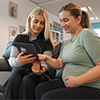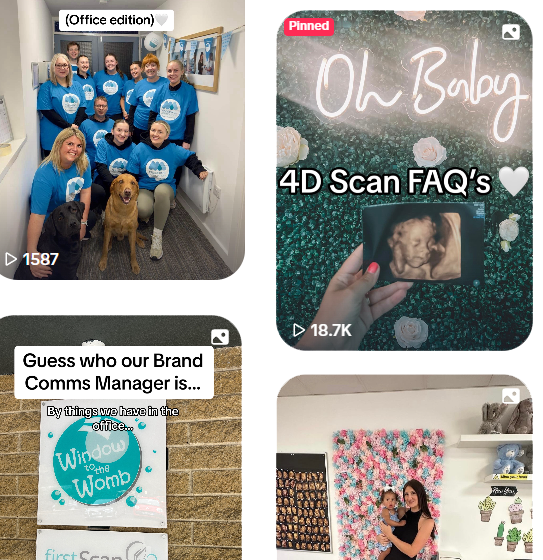A planned C-section can be a thoughtful choice for many reasons – whether it’s due to medical necessity, a previous birth experience, or simply personal preference. However, preparing for a C-section can feel a little different from preparing for a vaginal birth. At Window to the Womb, we’re here to offer you a gentle guide to help you feel as prepared and confident as possible for your big day.
Mental and Emotional Preparation
The first step in preparing for a planned C-section is addressing your emotional wellbeing. It’s completely normal to feel a mix of emotions, whether that’s excitement, anxiety, or even uncertainty. Here are a few things to keep in mind:
- Stay Informed: Having a solid understanding of the C-section procedure can help alleviate any fears or anxiety. At Window to the Womb, we’re here to support you with knowledge, including what happens before, during, and after the surgery. Don’t hesitate to ask questions at your pre-operative appointment, and feel free to bring a support person to help you feel more at ease.
- Focus on the Positives: A planned C-section allows you and your medical team to plan for the safest possible birth for you and your baby. You can choose the timing, and in some cases, even request a specific type of birth environment. It can also give you the opportunity to make thoughtful plans for your post-birth care, which can be reassuring.
- Prepare for the Recovery: After the birth, the recovery time from a C-section typically takes longer than from a vaginal birth, as it involves major surgery. Remember, it’s okay to ask for help, and giving yourself time to heal is important. Setting expectations for your recovery process will help you feel more in control.
Packing Your Hospital Bag
When preparing for a C-section, you’ll need to pack a few extra items compared to a vaginal birth. Here’s a list of essentials:
- Comfortable Clothing: Bring loose, soft clothing, especially around the abdominal area, as you will have a large incision. High-waisted maternity underwear or soft, stretchy pants are ideal.
- Post-Surgery Supplies: You’ll need items like large sanitary pads (since you’ll likely have lochia for several weeks), comfortable bras (consider nursing bras for ease), and pain relief medications (which will be provided by the hospital but you can ask for specific recommendations).
- Extra Pillows and a Blanket: Hospitals provide basic bedding, but having your own pillow or blanket can make the space feel a little more like home.
- Toiletries: Include your usual toiletries, as well as any items that help you feel relaxed and at ease, like lip balm, dry shampoo, and moisturiser.
- Snacks: C-sections often require you to fast before the surgery, but once you’re allowed to eat post-op, having a few snacks on hand will be appreciated!
- Your Birth Plan: Even if you have a planned C-section, there may still be things you’d like to communicate with your team, such as skin-to-skin contact, breastfeeding preferences, or the presence of your birth partner. Write these down to ensure your wishes are clear.
What Support to Have at Home
Your physical recovery after a C-section will require time and care, and it’s important to plan ahead to make sure you have enough help when you get home:
- Help with Housework: If you can, arrange for a friend, family member, or even a professional cleaner to help with housework. It’s important not to overexert yourself as you heal.
- Prepare for Baby Care: Have your partner or a loved one take on some of the baby duties in the early days, like diaper changes or night feeds. This will allow you to rest and recover without added stress.
- Meal Prep: Stock up on easy-to-prepare meals or have a friend/family member cook for you. Having nourishing meals on hand will make recovery easier and less overwhelming.
- Emotional Support: Sometimes, a C-section can bring a mix of emotions — both joy and sadness — and that’s okay. Lean on your support network for emotional support, whether it’s a friend, family member, or online support group. You don’t have to go through it alone.
The First Few Days Post-C-Section
Once your baby is born, you will need time to rest in the hospital, usually around 2 to 3 days. During this time, you’ll be monitored closely by your medical team. When you leave the hospital, make sure to:
- Take It Easy: Avoid any heavy lifting, bending, or strenuous activity. If you have a newborn, you’ll need help with certain tasks, like getting up from bed, handling the baby, or taking care of older children.
- Follow Medical Advice: Your healthcare team will provide you with instructions on wound care, pain management, and signs of infection to watch for.
- Ask for Help: Don’t hesitate to reach out to your support system for help, whether it’s for physical tasks, emotional support, or just having someone to talk to.
See our blog “What to Expect from a C-Section: Before, During & After” for more information on a c-section experience.
Stay Connected with Your Baby
Even with a C-section, you can have the same bonding experiences as those who have vaginal births. If you’ve opted for skin-to-skin, ask your birth team to place your baby on your chest as soon as possible after birth, or as soon as you’re able.
At Window to the Womb, we know how important it is to feel prepared and supported throughout your pregnancy and birth. Whether you’re having a C-section, a vaginal birth, or a planned home birth, our private scans can help you connect with your baby and get reassurance during every stage of pregnancy.
Book your reassurance scan with us today at www.windowtothewomb.co.uk and let us support you on your journey.













 Packages & Prices
Packages & Prices  Important Info & Policies
Important Info & Policies  Your Scan
Your Scan